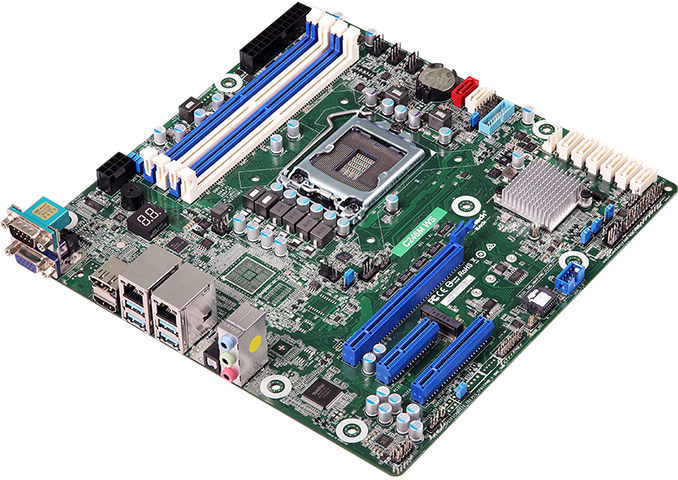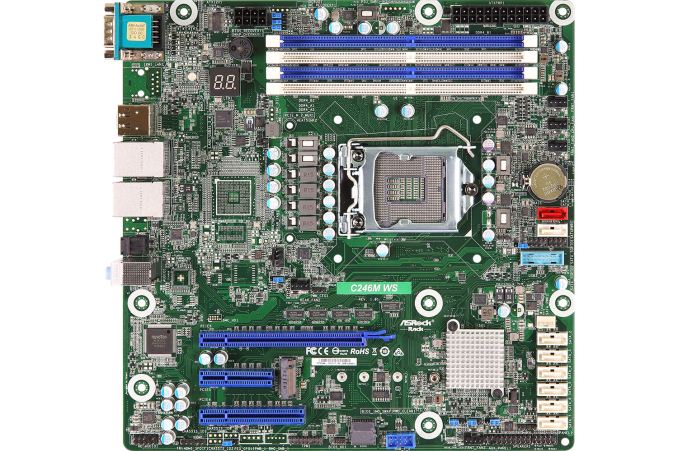ASRock Launches C246M WS Micro-ATX Motherboard for Xeon E CPUs
by Anton Shilov on July 16, 2018 2:00 PM EST- Posted in
- Motherboards
- ASRock
- Xeon
- Servers
- Xeon E
- Intel C246
- C246M WS

ASRock Rack has announced one of the industry’s first Micro-ATX motherboards for Intel’s new Xeon E processors for entry-level servers and workstations. The C246M WS platform is aimed at compact workstations, it supports a variety of PCIe add-in-cards, rather rich storage capabilities, and a couple of GbE connectors.
As the name suggests, the ASRock C246M WS motherboard is based on Intel’s C246 chipset and therefore supports Intel’s Xeon E-2100 series processors. The platform features a multi-phase VRM that uses solid-state inductors and capacitors to sustain stable operation during prolonged workloads. The design of the motherboard contains an empty pad for the Aspeed AST2500 IPMI chip, so eventually ASRock plans to launch a management version of the product as well. That server SKU will support IPMI 2.0 and will gain an additional Realtek RTL8211E Ethernet controller, the company’s website suggests. Probably for cost reduction reasons, the manufacturer decided not to install a TPM module onto its C246M WS workstation platform, but there is a TPM header, so the actual PC makers can still add this feature if their clients want it.
Just like other motherboards with the LGA1151 v2 socket, the C246M WS comes with four DDR4 DIMM slots supporting up to 64 GB of DDR4-2667 memory with ECC technology when a Xeon E processor is installed. PCIe 3.0 slots include one x16, one x8, and one x4 slot. The first one automatically switches to x8 mode once the second one is occupied.
When it comes to storage, the C246M WS has one M.2 PCIe 3.0 x4 slot (supports both NVMe and SATA drives), and eight SATA connectors (one connector shares SATA with the M.2 slot, hence no more than eight SATA drives per system no matter the form-factor). If all storage options are used, the C246M WS can support up to 12 drives in a Micro ATX system: four PCIe/NVMe SSDs (one M.2 + three PCIe 3.0 slots) as well as eight SATA HDDs/SSDs.
Moving on to connectivity offered by ASRock’s C246M WS. The motherboard has two GbE ports, four USB 3.1 Gen 2 Type-A connectors (there are internal headers too), a D-Sub output (will be needed mostly on a server version outfitted with the AST2500 IPMI chip), an HDMI output, a Serial port, and audio outputs (analog and digital).
| ASRock's Micro ATX Motherboard for Intel's Xeon E CPUs |
||
| C246M WS | ||
| Supported CPUs | LGA1151 v2 CPUs Xeon E 2100-series |
|
| PCH | Intel C246 | |
| Graphics | Intel UHD Graphics from CPU PCIe 3.0 x16 slot |
|
| Display Outputs | 1 × D-Sub 1 × HDMI |
|
| Memory | 4 × DDR4 DIMM Up to 64 GB of DDR4-2667 ECC or non-ECC |
|
| Slots for Add-In-Cards | 1 × PCIe 3.0 x8 1 × PCIe 3.0 x4 |
|
| Ethernet | LAN 1: Intel I219LM GbE PHY LAN 2: Intel I210AT GbE PHY |
|
| Storage | 8 × SATA 6 Gbps (one SATA port is logically shared with M.2) 1 × M.2 (PCIe 3.0 x4 or SATA) |
|
| Audio | Multi-channel audio with 3.5-mm and S/P DIF outputs | |
| USB | 4 × USB 3.1 Gen 2 Type-A Internal headers for 2 USB 2.0 and 2 USB 3.0 ports |
|
| Serial Ports | 1 × RS232 | |
| Wi-Fi | - | |
| Operating Temperature | 10°C~35°C | |
| Form-Factor | Micro ATX (244 mm × 244 mm | 9.6" × 9.6") | |
ASRock Rack generally sells products to businesses, so expect the C246M WS to show up inside entry-level compact workstations in the coming months. It is unclear when (if at all) the C246M WS emerges in retail and at what price point.
Related Reading
Source: ASRock












10 Comments
View All Comments
The Chill Blueberry - Monday, July 16, 2018 - link
What would that unused "West bridge" be? (The exposed BGA connection between the CPU power delivery and the rear I/O) On-board wireless? Second chipset?ArtForz - Monday, July 16, 2018 - link
"The design of the motherboard contains an empty pad for the Aspeed AST2500 IPMI chip"JoeyJoJo123 - Monday, July 16, 2018 - link
Any logical design benefits to rotating the CPU and memory locations like that on the board? I'm guessing they only did so as a requirement to have PCB space available for that IPMI chip, but I feel AsRock's probably been one of the best at making good design decisions on constrained board space (see their MiniITX and MicroATX options for Intel Enthusiast series boards in the past, whereas most other manufacturers make ATX or EATX boards for those platforms.)I mean, I guess it just looks odd to me. It probably doesn't have much of a negative effect (if anything) on compatibility with coolers or overall board quality.
prisonerX - Monday, July 16, 2018 - link
Yes, it's so you can cool the damn thing properly. Cold air comes in the front and blows out the back (the 'rear' ports may be on the front or back in this arrangement) . DIMM slots need to be aligned in the direction of airflow as does the long side of the CPU heatsink, which in this case would likely also cover the power circuitry.The fact that consumer mobos orient the DIMM slots the wrong way (90 deg to airflow) is a big reason why they're useless for high density applications. That is probably intentional.
DanNeely - Monday, July 16, 2018 - link
historically blast from the front cooling like server boards use wouldn't work in consumer cases because they'd have drive bays in front of the mobo not fans. Instead the dimms are oriented to maximize convection of the hot air up to the top of the case where the ATX standard put the PSU with its exhaust fan. Dimms oriented server style would serve as baffles to trap the hot air below them in a standard consumer layout. Different airflow patterns need different board layouts.prisonerX - Wednesday, July 18, 2018 - link
What makes me laugh is the suggestion that there was/is some sort of thermal design put into ATX anything.DanNeely - Monday, July 16, 2018 - link
High density servers are cooled by a bank of fans on the front of the chassis/blade blowing front to back because there's not enough room above the board for the heat to rise and be pulled out by the fan above IO panel or on the top of the case.dsplover - Monday, July 23, 2018 - link
I use Supermicro 1U Chassis and ASRock WS boards. The DIMMs are set up perfectly as triple fans shaped like barrels blow through the DIMMs and make sure a plain old thick Copper Heat Sink is fine. Or one could use the Dynatron L3 Water Cooled Server which attaches the radiator to triple barrel fans.I’m still running H97 and C236 ASRocks and full load they run cool.
This board will be my next build and for the sake of lower fan noise, the Dynatron L3.
These barrel fans from Supermicro can top out at 22k rpm.
Louder than my wife’s Shark Vacuum.
This is a great board. I’ll be using the E-2174G quad CPU though.
Lower watts, lower temps.
Can’t wait..
dsplover - Thursday, July 26, 2018 - link
Good fit for 1U.https://postimg.cc/image/94ggic5xn/">[img]https://s33.postimg.cc/94ggic5xn/3_A3_A5228-9_A97-...[/img]
bolkhov - Tuesday, July 17, 2018 - link
DisplayPort output is clearly visible above HDMI.But it isn't mentioned in specs.
On the other hand, the D-Sub, which "will be needed mostly on a server version outfitted with the AST2500 IPMI chip": how can it work WITHOUT a BMC (absent on this one)?